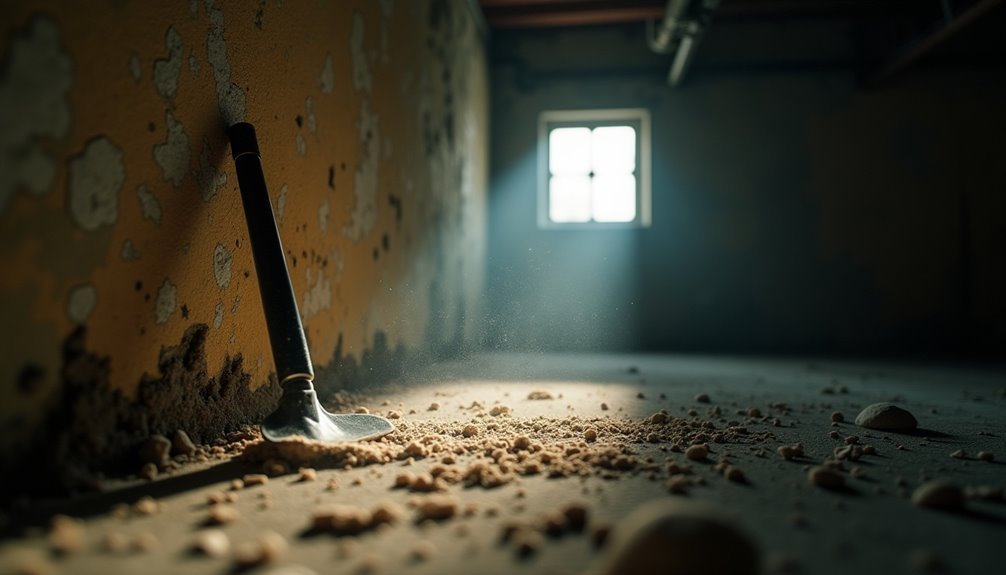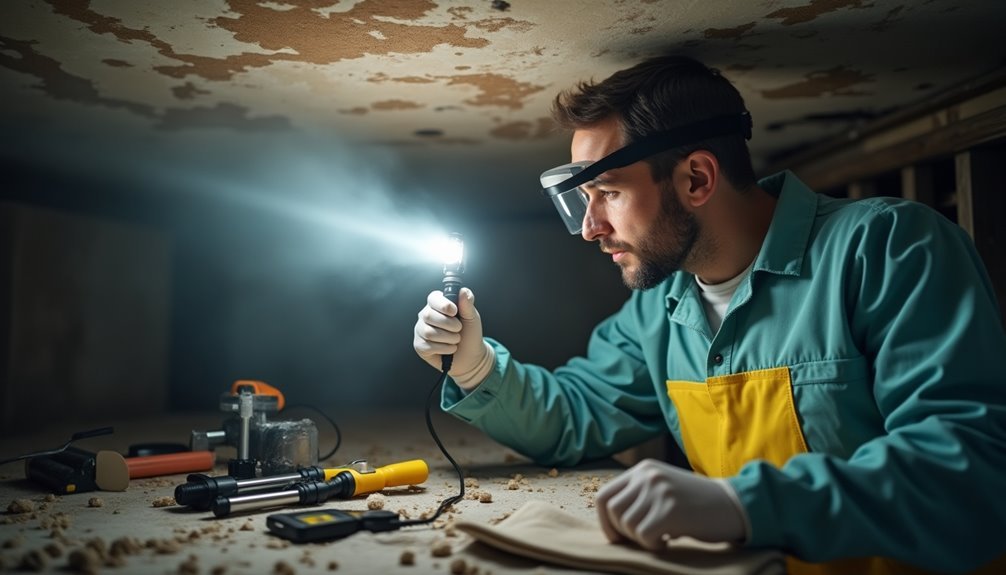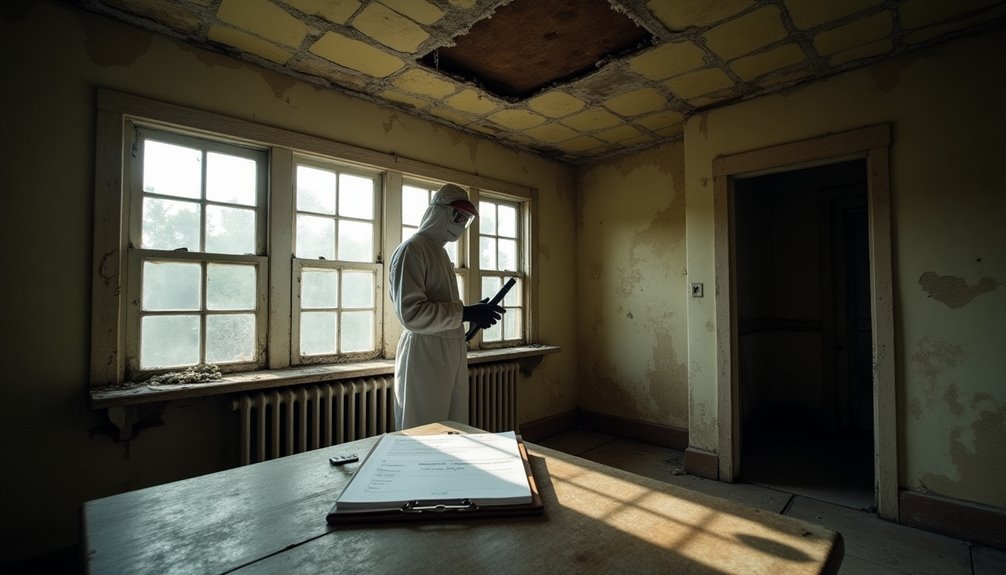Your home may be at risk if it contains asbestos, a hazardous material linked to severe health issues like lung cancer and asbestosis. Regular inspections are crucial for identifying and managing asbestos safely. They not only help ensure compliance with local regulations but also protect your property value, as homes with asbestos can see a significant decrease in market appeal. Early detection via inspections can prevent costly remediation and reduce insurance complications. By understanding the importance of regular asbestos assessments, you can make informed decisions to safeguard your home and health. Discover the key steps to take next.
History of Asbestos Use

Asbestos has a long and complex history that spans over 4,500 years, showcasing its transformation from a valuable mineral in ancient civilizations to a major industrial material. Early on, people recognized its unique properties, using it to create durable pots and textiles, often dubbing it the "magic mineral." The modern asbestos industry emerged in the 1800s, particularly in Italy, paving the way for widespread asbestos applications. By the mid-19th century, Henry Ward Johns founded the H.W. Johns Manufacturing Company, producing fireproof roofing materials, marking a significant milestone in commercialization.
The Industrial Revolution further accelerated asbestos production and usage, as it became integral in insulation for steam engines, boilers, and electrical generators. By the early 1900s, its applications expanded into building materials, with technologies like Hatschek enabling mass production of fireproof components. The United States emerged as the leading consumer, accounting for around 43% of global production by 1910. Asbestos consumption peaked while asbestos played a vital role in industrial development, its historical significance is now intertwined with the awareness of its potential dangers, necessitating regular inspections to assess risks in your environment.
Health Risks of Asbestos
As you consider the health risks of asbestos, it's crucial to understand that exposure significantly increases your chances of developing lung cancer and other serious respiratory conditions like asbestosis. Symptoms might not show up for decades, which makes early detection challenging. Certain populations, particularly those in high-exposure workplaces, are especially vulnerable to these devastating health effects. All asbestos fibers are harmful if breathed, highlighting the importance of regular inspections to prevent exposure.
Lung Cancer Risks
Exposure to asbestos poses significant lung cancer risks, primarily due to the inhalation of microscopic fibers that become lodged in lung tissue. This leads to inflammation and damage, creating a pathway for cancer development. It's crucial to understand the following factors related to asbestos exposure and lung cancer:
- All forms of asbestos increase lung cancer risk.
- The greater the exposure to asbestos, the higher the risk of developing lung cancer.
- Smoking significantly amplifies this risk, creating a dangerous combination.
- Other environmental pollutants can further elevate your risk when combined with asbestos.
Each year, thousands of individuals succumb to asbestos-related lung cancer, highlighting the need for vigilance. The latency period can exceed a decade, meaning symptoms may not appear until long after exposure. Regular health checkups, including chest x-rays and CT scans, are vital for early detection and improving outcomes. If you suspect asbestos in your home or workplace, consider scheduling an inspection. Protecting yourself from these risks is essential for your long-term health and well-being. Remember, knowledge is power in the fight against lung cancer linked to asbestos exposure.
Asbestosis Symptoms
Recognizing the symptoms of asbestosis is crucial for anyone with a history of asbestos exposure. You might experience shortness of breath, a persistent dry cough, and chest tightness or pain. As the condition progresses, dry and crackling sounds may occur in your lungs when inhaling, and you could notice clubbing of your fingers and toes. These symptoms typically develop 10-40 years after initial exposure, often appearing as early as 15-20 years down the line.
It's important to understand that early signs can be mistaken for common respiratory issues, which may complicate your asbestosis diagnosis. As the disease worsens, the risk of respiratory complications increases, leading to reduced lung function and potential weight loss.
If you're experiencing increasing shortness of breath, consult a healthcare provider immediately. Tests like low-dose CT scans can help detect early signs of asbestos-related diseases. Early detection is vital for better outcomes and appropriate asbestosis treatment. Misdiagnosis is common due to symptom overlap with other respiratory ailments, so seeking specialist evaluation is essential for accurate diagnosis and care.
Vulnerable Populations
Individuals affected by asbestosis face heightened health risks, especially when considering the broader impact of asbestos exposure on vulnerable populations. Vulnerable communities often experience disproportionate exposure through various pathways, including environmental, para-occupational, and natural sources. This exposure can lead to clusters of asbestos-related diseases (ARDs), particularly mesothelioma, impacting women and younger individuals more than those in occupational settings.
Here are four critical factors influencing these health risks:
- Genetic predisposition: Certain individuals may be more susceptible to ARDs due to inherited traits.
- Age at exposure: Younger populations exposed to asbestos may face increased risks as they age.
- Social factors: Behavioral and social determinants can exacerbate the impact of asbestos exposure, particularly during extreme events.
- Fiber type: Different asbestos fibers carry varying levels of risk, affecting health outcomes.
Recognizing these factors is essential for addressing the health disparities in vulnerable populations. Regular asbestos inspections can help mitigate risks, ensuring safer environments and protecting community health.
Importance of Inspections

Understanding the importance of asbestos inspections is vital for your safety and legal compliance. Regular inspections not only help mitigate health risks associated with asbestos exposure but also ensure you meet necessary regulations, protecting your property value. By identifying asbestos-containing materials, you can develop effective management strategies to minimize any potential hazards.
Health Risk Mitigation
Amid rising concerns over asbestos exposure, regular inspections play a crucial role in health risk mitigation by identifying hazardous materials before they can cause harm. By enhancing asbestos awareness, you can effectively reduce the risks associated with exposure. Here's why regular inspections are essential:
- Early Detection: Frequent inspections help identify asbestos-containing materials (ACMs) before they deteriorate, preventing fiber release into the air.
- Preventive Action: Early identification allows you to implement safety measures, reducing the likelihood of harmful exposure.
- Informed Decisions: Knowing the condition of ACMs enables you to make informed decisions, especially before renovation or demolition activities.
- Long-Term Monitoring: Ongoing inspections contribute to a comprehensive understanding of asbestos presence, ensuring continuous risk reduction over time.
The repercussions of asbestos exposure can be dire, leading to serious health conditions like lung cancer and mesothelioma. By prioritizing regular inspections, you're not only safeguarding your health but also that of your loved ones. Ultimately, fostering an environment of asbestos awareness empowers you to take proactive steps in mitigating significant health risks.
Legal Compliance Assurance
Ensuring legal compliance with asbestos regulations is crucial for any property owner or manager. Failing to meet your legal obligations can lead to severe penalties and enforcement actions. Asbestos inspections are mandated under the Asbestos National Emission Standards for Hazardous Air Pollutants (NESHAP), requiring certified inspectors to identify asbestos-containing materials (ACM). Before any renovation or demolition, you must notify the relevant state or local air program authority, ensuring that your activities align with regulatory compliance.
In many states, including Oregon and New York, asbestos surveys are mandatory for buildings constructed before 2004. Even in cases where exemptions exist, such as in buildings built after April 1987 in New York, any known ACM must still be properly abated. Compliance with local regulations, like those in New York City, adds another layer of oversight, requiring assessments and certifications for renovation projects.
Additionally, specific activities such as demolition or remodeling necessitate thorough asbestos surveys. Regular inspections and updated management plans are essential, especially in public schools, where strict guidelines under the Asbestos Hazard Emergency Response Act (AHERA) apply. Prioritizing these inspections ensures you meet your legal obligations and protects your property from potential legal repercussions.
Property Value Protection
When it comes to protecting your property value, conducting regular asbestos inspections is not just advisable—it's essential. The presence of asbestos can lead to significant property depreciation, often resulting in homes selling for 5-15% less than comparable asbestos-free properties. This decline in value is influenced by factors like the extent and location of asbestos in your home, with critical structural components having a more pronounced effect.
Here are four key reasons to prioritize regular inspections:
- Market Value Maintenance: Identifying and addressing asbestos can prevent drastic drops in your property's market value.
- Enhanced Buyer Perceptions: Potential buyers often view asbestos as a serious health risk, impacting their willingness to engage.
- Negotiation Leverage: A proactive inspection can provide you with leverage in negotiations, potentially leading to better offers.
- Cost-Efficiency: Addressing asbestos issues before they escalate can save you from costly removal expenses and increased insurance premiums.
Recommended Survey Frequency
To maintain safety and compliance, determining the recommended survey frequency for asbestos inspections is crucial. The age of your building plays a significant role; structures built before 2000 are more likely to contain asbestos materials, necessitating more frequent checks. If previous inspections revealed extensive asbestos-containing materials (ACMs) or high-risk areas, you'll want to shorten your inspection intervals to ensure safety.
For most properties, annual or bi-annual inspections are advisable. Inspectors typically recommend assessing the condition of known ACMs every six to twelve months. Schools must comply with AHERA regulations, requiring re-inspections at least once every three years. Additionally, if your building undergoes renovations or demolitions, it's essential to conduct a thorough asbestos survey beforehand.
The condition of ACMs is another critical factor; damaged or deteriorating materials require closer monitoring. Buildings with high occupancy or varying usage patterns should also have more regular surveys to mitigate risks effectively. By adhering to these recommended inspection intervals, you can ensure a safer environment for all occupants while remaining compliant with legal and regulatory requirements.
Inspection Process Overview

Beginning with a thorough initial assessment is essential in the asbestos inspection process. This step lays the foundation for identifying potential risks and forming an effective inspection plan. You'll want to ensure your inspection encompasses the following key components:
- Historical Review: Examine the property's history to pinpoint periods when asbestos was commonly used.
- Visual Assessment: Conduct a comprehensive visual inspection of accessible areas to identify probable asbestos-containing materials.
- Sampling Techniques: Utilize specialized tools to collect samples from suspect materials without disturbing the fibers. These samples are critical for accurate analysis.
- Documentation: Record all findings meticulously to support a robust risk assessment.
Following this initial phase, a physical inspection delves deeper into the conditions of materials. It includes examining for physical damage and gathering samples for laboratory analysis. The insights gained from both the visual assessment and sampling techniques guide the determination of the presence and condition of asbestos fibers. Ultimately, this structured approach ensures you're well-informed about potential risks, providing a pathway to effective management strategies.
Benefits of Regular Inspections
Recognizing the benefits of regular asbestos inspections is crucial for maintaining a safe and healthy environment in your home. By prioritizing asbestos awareness, you not only protect your family but also enhance your property's value. Regular inspections help identify asbestos-containing materials (ACMs) before they can deteriorate, minimizing exposure risks and preventing serious health issues like lung cancer and mesothelioma.
Here's a quick overview of the benefits you gain from consistent asbestos inspections:
| Benefit | Description |
|---|---|
| Health Protection | Reduces risk of asbestos exposure for you and your family. |
| Early Detection | Identifies potential hazards before they escalate. |
| Financial Savings | Prevents costly issues and enhances property value. |
| Compliance Support | Helps you adhere to regulations, avoiding fines. |
| Maintenance Efficiency | Improves planning for safe repairs and renovations. |
Establishing an inspection frequency that fits your needs ensures ongoing safety and keeps your home a welcoming space. By being proactive, you create a healthier environment, allowing your family to thrive without the looming threat of asbestos hazards.
Legal Compliance and Responsibilities

Regularly ensuring legal compliance in asbestos management is vital for safeguarding both public health and your property. You have specific legal obligations under the regulatory framework that must be met to avoid serious consequences. Here are four key responsibilities you should be aware of:
- Conduct Mandatory Surveys: Before any renovation or demolition, an asbestos survey must be performed by certified professionals to identify potential asbestos-containing materials (ACM).
- Hire Qualified Inspectors: Ensure that the inspectors you hire are certified by relevant authorities, such as the EPA or Cal/OSHA, and have no conflicts of interest related to the project.
- Maintain Thorough Documentation: The survey report must include comprehensive details of the inspection, findings, and recommendations, all signed by a certified consultant to verify its accuracy.
- Adhere to Enforcement Regulations: Failure to comply with asbestos regulations can lead to legal penalties. Always engage licensed asbestos abatement contractors when dealing with ACM to ensure that safety measures are followed.
Protecting Your Home Value
Asbestos can be a hidden threat to your home's value, dramatically affecting market perceptions and financial stability. The presence of asbestos can lead to significant drops in property appraisal, as potential buyers often hesitate due to health risks and high remediation costs. Regular inspections can mitigate these risks, offering a proactive solution to maintain your home's market value.
| Impact Type | Description | Financial Consequences |
|---|---|---|
| Market Value | Asbestos presence can decrease property appeal. | Potential buyers may negotiate lower prices. |
| Remediation Costs | Asbestos removal can cost thousands of dollars. | Homeowners bear full financial responsibility. |
| Insurance Implications | Elevated premiums or exclusions can occur. | Higher long-term financial risks without coverage. |
Conclusion
Regular asbestos inspections are crucial for safeguarding your home and health. Did you know that approximately 1.3 million workers in the U.S. are still exposed to asbestos on the job? This statistic highlights the ongoing risks associated with this hazardous material. By prioritizing inspections, you not only comply with legal obligations but also enhance your property's value and protect your loved ones from potential health issues. Stay proactive—your home's safety depends on it.
